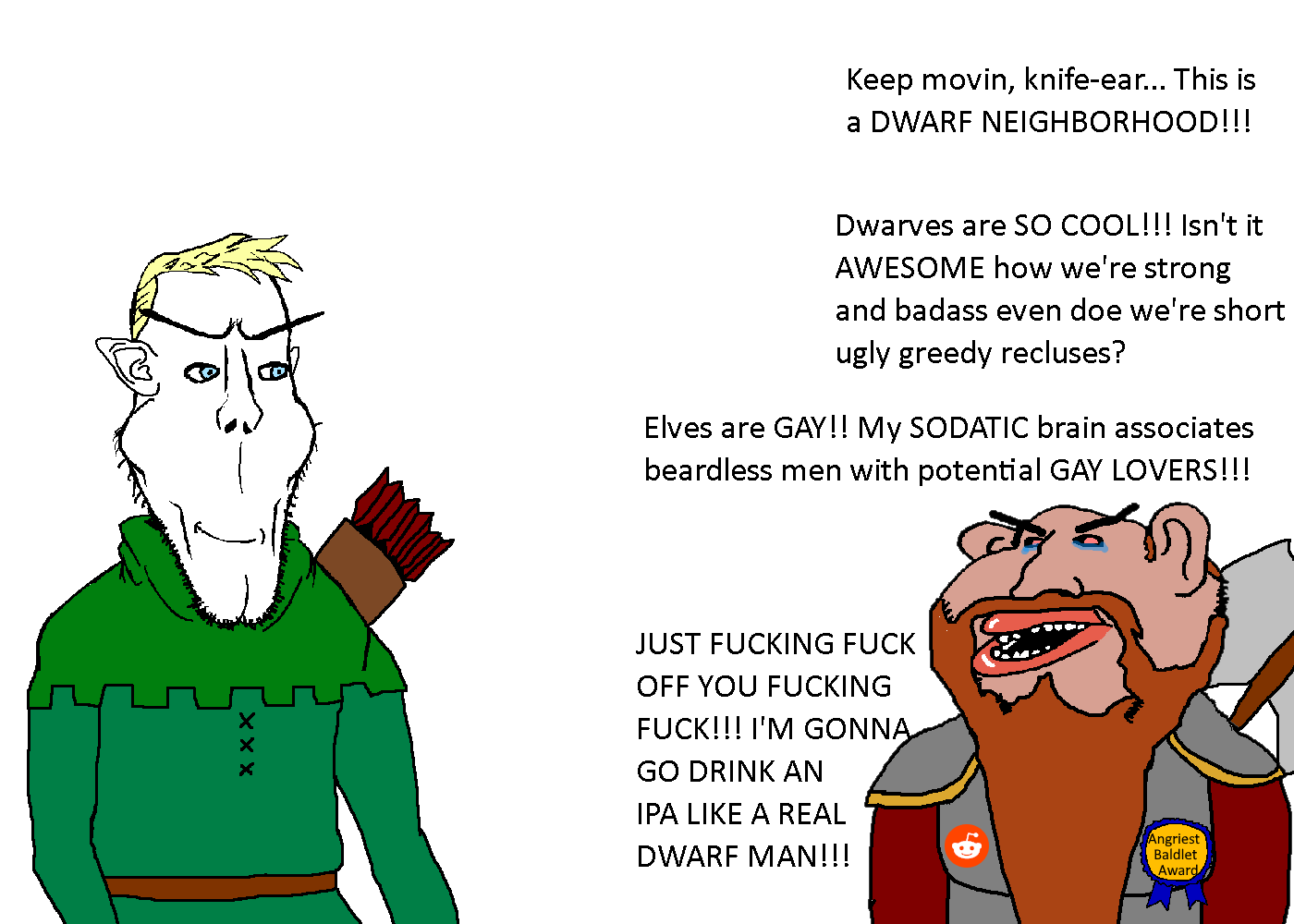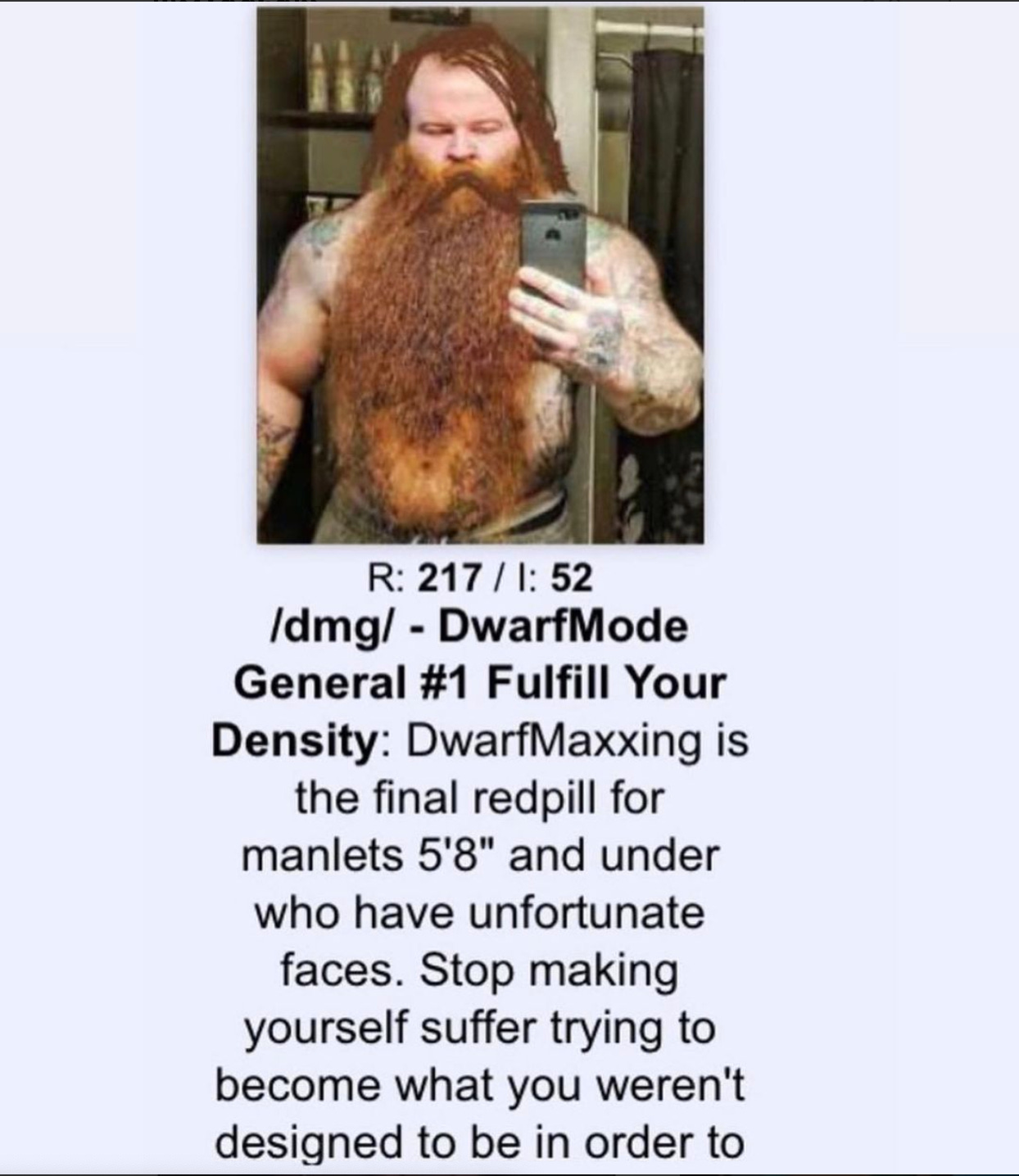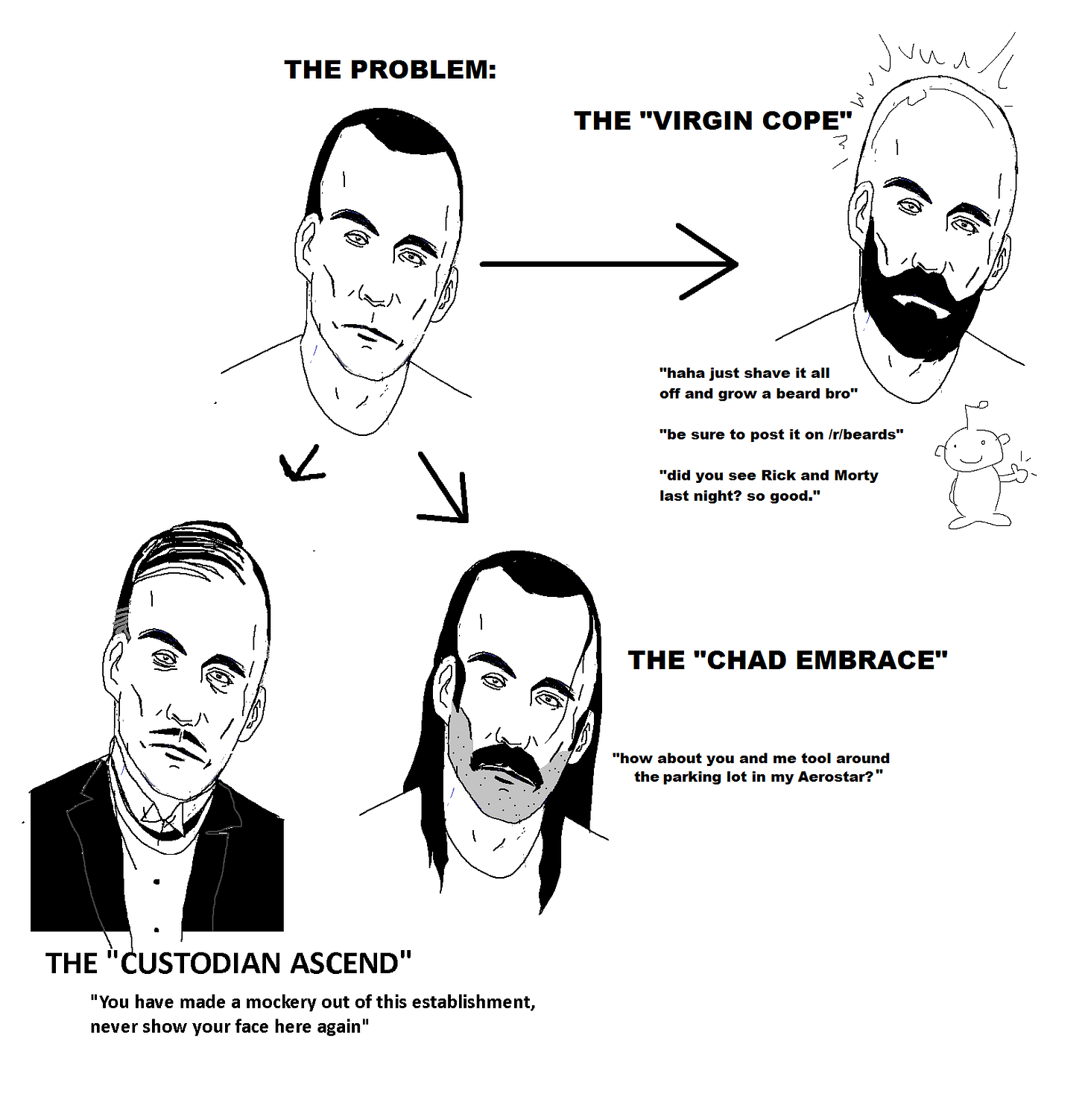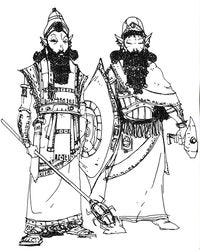AGAINST DWARFMAXXING
Low-Information Post + Upsetting DrawvenAllFather Part 2
It’s a well-known fact that a man can be short, or he can have a bad hairline. If you’re short and balding at the same time, you’re in a lot of trouble. Men who suffer from these ailments should be given advice to mitigate these faults, but instead I often see people doing the opposite. Instead of just trying to look good in spite of your faults, men with these problems are encouraged to play into them through “Dwarfmaxxing”.
From a practical standpoint of getting “huzz”, it’s probably not the worst advice, but in my opinion it is heavily misleading. Encouraging smaller guys to bulk up is legitimately good advice, but the “Dwarf Physique” is intentionally vague and can lead to people falling down the dark path of “strongfat”. Women do not typically find short chubby guys attractive, even if they can bench press an adult male boar. At best, the extra top-heavy mass can give the illusion of height if you’re only just barely short, but if you’re below 5’7 you’re risking being in the “giant baby” range. Being short isn’t going to ruin your entire look if you just do what normal people do to look better. I was just recently at a Halloween party, and saw a staggering amount of conventionally attractive skinny manlets with women at eye level or noticeably taller than them (at least while wearing heels). However, I saw virtually zero fat people (aside from women, of course). Then there’s the “Bald-Beard” advice.
There are three problems with this approach. Firstly, most men genuinely just struggle to grow good beards. Telling someone to grow a beard is like telling a bald person to just “grow out their hair”. Often times, they just can’t do it. I’m speaking, of course, as one of the lucky ones, who is constantly hearing the men around him complain about how they “can’t grow a beard like that”. Women often erroneously compare beards to makeup, when it would be more correct to call them something of a natural burqa. When a third of the face is hidden, onlookers naively simulate it in their minds as what the average part of that face would look like. Luckily, women’s perception of average is skewed upwards, even more than men’s, so growing a beard is a boost for more than half of men. For those who have an above-average lower third, however, it might actually be something of a debuff. They go from uniquely attractive to just another bearded fellow. What’s worse is that the people who are getting advice to grow a beard are probably the last people who should be doing so. Beards accentuate bald foreheads. It’s a literal inversion of where hair is supposed to be, which makes it more jarring than an ordinarily bald or ordinarily receding head. When I see a balding guy with a beard, I notice how much thicker the hair on his chin is than the hair on his dome. I think beards are also starting to accentuate shortness, for similar reasons. People see this guy with a beard and think, “wait, this isn’t right. Why is this bearded individual as tall as a 14 year old? Aren’t beards supposed to be a trait of maturity?”
Oh yeah, and shaving it all off doesn’t make you any less bald. Everyone knows that most artificially bald people are just actual baldies or half-baldies who finish the job with a razor, especially after that five o’clock shadow starts coming in.
I can already hear someone saying it. “We don’t do it for them”. You know, the holes. The cuntoids. The roasties. It’s not about what wamen think. It’s about the AURA of being a LE EBIC DWARF and shit… And that’s actually what I really wanted to talk about anyways! Because I actually don’t get the Dwarf-mania. They are, in almost all of their iterations, not a very admirable race, but people completely misunderstand what they’re supposed to be. Many people seem to imagine Dwarfs as this sort of Nordic Viking culture, because Dwarfs are staples of Norse mythology, but there is perhaps no other less Nordic race… Dwarfs are treated with ambivalence at best in Norse mythology. They are cthonic in substance, originating as maggots feasting on the flesh of Ymir. They do work which the gods abandoned, and are often at quarrel with the gods. They are portrayed as greedy and untrustworthy, not evil like the Jotnar but not worthy of worship like the Elves. They may actually be identical to Dark Elves. The same ambivalence surrounds Dwarfs in German medieval poetry, where in several myths Dwarfs take a similar position to dragons as hoarders of treasure. In both Norse myth and German poetry, Dwarfs are missing some of their characteristics that would be created later. They were already subterranean, maybe diminutive, and associated with smithing, but they are sometimes treated more like spirits rather than embodied creatures.
The two earliest major sources for Dwarfs as they are understood today are Wagner’s Ring Cycle and The Hobbit. In both circumstances, Dwarfs are juxtaposed with the Nordic-coded cultures in the same stories, instead of being examples of them. Wagner’s King Alberich is a greedy and conniving Dwarf tyrant who has sacrificed love for absolute power and wealth, and his brother Mime is the resentful and cowardly guardian of the heroic Siegfried (who he eventually plans to kill, and is only using him). Many people believe that Wagner meant to portray the Dwarfs as Jewish stereotypes. However, in private, Wagner actually stated that he imagined them as more Mongoloid in physical type, and was surprised when a Jewish actor was chosen to play Mime.
Tolkien’s Dwarves, on the other hand, are much more unambiguously semitic. Their language is based on semitic languages, and Tolkien describes them as Jewish in interviews. Short, big-nosed, bearded men who wander from place to place due to being expelled from their home… Who also happen to work all sorts of odd jobs rather than living off the land, and who have a vice of greed… Yes, it really couldn’t get more obvious than that. Don’t take it from me, take it from him:
“The dwarves of course are quite obviously, couldn’t you say that in many ways they remind you of the Jews? Their words are Semitic obviously, constructed to be Semitic. [...] There’s a tremendous love of the artefact, and of course the immense warlike capacity of the Jews, which we tend to forget nowadays.”
And it isn’t like Tolkien really portrays Dwarves in a great light. Their obsession with physical wealth is contrasted heavily with the simplicity of the Hobbits, and it leads often to their ruin. They cordon themselves off from the world, but simultaneously expect shelter from their hosts — and they aren’t exactly good guests. Kinda reminds me of a certain nation of people in the real world…
This trend of Dwarfs as semitic continues in later renditions of the fantasy race, which are heavily inspired by Tolkien’s Dwarves rather than the older Dwarfs in folklore. The spelling difference was intentional on Tolkien’s part, as he wanted to distinguish his own race from the actual Dwarfs in Germanic myth. The most notable instance of semitic Dwarves I can think of outside of Tolkien is in The Elder Scrolls. The vaguely Mesopotamian or Bronze-Age Levantine getup of the Dwemer is difficult to deny. They feature the classic “bound beards” that are seen being sported by Akkadian and Assyrian kings, rather than the thick-braided beards associated with Vikings. Their place names look semitic or possibly even Hurrian, the language which Tolkien’s Black Speech was based on. It makes sense, since they are supposed to be this ancient advanced civilization, and Mesopotamia is widely recognized as the earliest civilization.
In all fairness, there are semitic elements to all of the Mer in the Elder Scrolls, but most of these are due to inspiration from real-life semitic religious terms. The other races of Mer aren’t particularly semitic in their culture. Altmer are Anglo-Japanese, Orsimer are vaguely Mongolic, and Dunmer are everything under the sun.
The final example, I guess, would be D&D. The two main subraces of Dwarves in D&D are Hill Dwarves and Mountain Dwarves. The latter is pretty similar to the Tolkien Dwarf, while the former is distinguished by being quite dark-skinned. This is arguably quite accurate to the original identification of Dwarves with Svartálfar (literally “Swarthy Elf” or “Dusky Elf”). I don’t know enough about D&D/FR to really talk about this, but it does deviate a lot from the “Nordic Dwarf” type.
The idea that the Nordics are a “mountain race” is far-fetched already. Yes, Norway is mountainous, but most of the homeland of the early Germanic tribes is incredibly flat. Nordics aren’t really Ice-Types, they’re Water-Types. Germans don’t have the appreciation for smithing that groups like Slavs, Finns, and most likely early Indo-Iranics did. Fire is associated with evil in Germanic myth. Real-world mountain races are actually hard to come by. I was thinking the Basques might work, but if you look at their history they’re much more of a maritime people. The early Celts were somewhat of a mountain people, spreading from the Alps into the Carpathians and French Uplands, and even today one of the main surviving Celtic cultures is that of the Scottish Highlanders. The challenge with fitting Dwarves into reality is that people who live atop mountains are very different from the type of race that would live within. They aren’t mining peoples, they are typically herders.
The urge to identify with a diminutive, subterranean race is nonetheless very compelling. I can’t lie, I very much understand the appeal. Hobbits are an interesting second option, but I think you have to Hobbitmaxx in moderation. We all like feeling a bit hobbit-like once in a while, but it isn’t ideal if you seek a higher purpose. Hobbits are very complacent and I think those sorts of environments in real life are suffocating. In my experience, a lot of modern hobbit/halfling fans are super woke and annoying, and are part of that whole “gremlin/silly-little-guy” subculture of infantile adults. I remember getting pretty annoyed watching the “Tales of the Shire” trailer, because it just looked like animal crossing if it was more effete and gay and worse in every way.
It should be no surprise to some of my more long-time followers that I’m a big fan of Gnomes, and I think they strike a nice middle-ground between the Dwarves and the Hobbits. They aren’t grossly technical like the Dwarfs, but they have a bit of an edge to them. A bit of a mischievous bunch. Problem is, Gnomes are very ill-defined. Gnomes were originally spirits of the mines, which you’d imagine as something more Dwarfish, and they’re not really friendly. I think the mining element of Dwarves came from Gnomes, while the smithing element came from Dwarfs. We use the term Gnome today to describe something a little closer in form to household spirits like Nisse, Kobolds, and Brownies. They live underground, but not deep underground. Just a little bit underground, and in smaller communities rather than the giant subterranean complexes of the Dwarves. An entire article is really owed to Gnome-like creatures at this point — if not by me, then by someone else. They essentially represent the continuation of the cult of the household spirits that existed in Pagan times, even being made offerings in exchange for labor or protection. The Christians, however, did not consider this to be an act of sacrifice to a lower deity, which demonstrates how real people imagined(?) these creatures as being.
The obvious best fantasy race, aside from humans, is elves (light elves, specifically), but they are often done dirty. In Norse mythology, Light Elves are nearly godlike in their status and treatment, being objects to which sacrifice is devoted and occupying a higher heaven than that of men. They may represent, at least at times, the reincarnated souls of especially virtuous dead men, which would make the land of the Light Elves perhaps something akin to the Buddha-Field… They were re-created as demonic or at best djinn-like in Christian Europe, and gradually de-humanized, until Tolkien brought them back as a sort of race. Since then, they have once again began to decay in pop culture. They almost retained their immortal status in Tolkien’s works, only being one step away from it, but in later stories they were either subverted into being prude, snobby chauvinists, or they were diminished into being pointy-eared blond vegans whose only advantage is that they live longer (but not forever) and they have something of an affinity for magic. Elves are nordic, Dwarfs are Asiatic, and yet today we think of Viking-like Dwarves and scheming semitic Elves (ex: Altmer).







Gnomes are real and reside in Latinx America
Great article, but gnomemaxxing is based and we need moar gnomes.